For business leaders, 2022 was defined by push-and-pull in the workplace. Employees and employers alike joined in on the debate on return-to-office (RTO) policies, work-life balance, workplace experience, and more. And it didn’t help that a major economic downturn impacted businesses and altered the layout of their organizations.Leaders today have a lot to navigate. They have to realign on the best strategies for the workplace of 2023. They have to figure out how to create a seamless workplace experience and maintain high levels of employee engagement, all while staying afloat in a tough market. Sound stressful? Well, it’s a lot easier to navigate if you’re aware of the most popular trends that are shaping the workplace so you can prepare for what’s ahead.Check out At Work: the 2023 workplace trends report to get a holistic picture of what happened to the workplace in the last year. But if you’re short on time, here’s the skinny on six of the most notable workplace trends from 2022 that leaders should be aware of.
Trend #1: Employees and visitors are spending more time onsite
According to our workplace trends report, workplace entries from employees and visitors around the globe grew from 2021 to 2022 by 37%. However, the growth in foot traffic wasn’t always consistent. In fact, foot traffic was quite volatile throughout 2022.A potential reason for volatility could be that companies set off with ambitious and hopeful return-to-office policies in the first half of year, but weren’t able to follow through with them. Notable tech companies including Apple and Google doubled down on their RTO policies in the Spring, which began the trend of mandatory in-office work blended with hybrid work. However, in the summer, foot traffic began to dip. Some of that dip can be attributed to seasonality. Folks took time off to travel, spend time with kids at home, or simply recharge their batteries.It’s important to note that our data is of mostly tech companies, who were the most impacted by economic volatility. Other industries didn’t see as much fluctuation, contributing to overall growth in foot traffic across all industries.

{{protip-1}}
Trend #2: The middle of the week is the most popular for onsite work
Not every day is treated equally when it comes to return-to-office. Some days are simply more favorable for going into the workplace. According to our data, Tuesdays and Wednesdays were the most popular days to go onsite, with Friday being the least popular. In fact, the gap between foot traffic in the middle of the week and tail ends of the week increased during 2022. At the start of the year, Tuesdays through Thursdays accounted for 63% of all foot traffic. But by the end of the year, the middle of the week accounted for 74% of weekday foot traffic.The middle of the week has been a favorite for hybrid employees who use these days to collaborate with their colleagues onsite. Mondays and Fridays are their head-down focus days. Significantly fewer folks went in on Fridays, possibly brought on by companies experimenting with four-day workweeks.
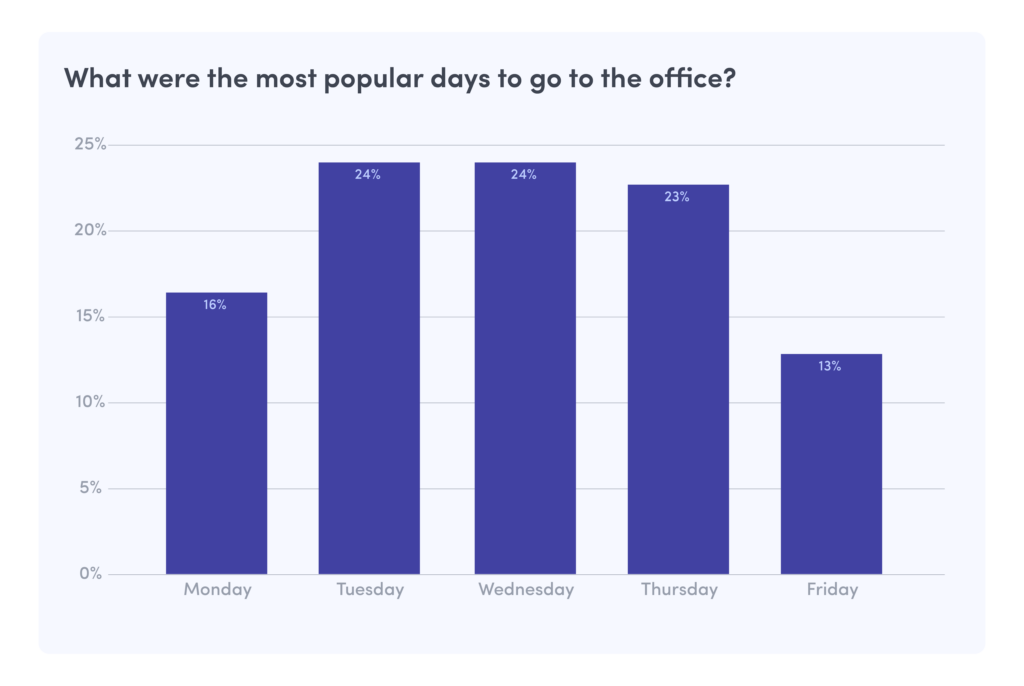
{{protip-2}}
Trend #3: Employees embrace flexibility when they come onsite
One of the things that makes hybrid work, well… work, is planning out your week. Which days will you schedule to work onsite versus remote? We were interested to see how far in advance employees planned their hybrid workweek. According to our data, 81% of employees did same-day scheduling. That means employees scheduled their office days in the morning before heading in or even as they're walking up to the front door. However, some employees were early planners. 10% of hybrid employees scheduled their days onsite a month before. These folks were probably at companies with more consistent RTO policies, so they knew what to expect in their schedules and liked to know what their month ahead looked like.
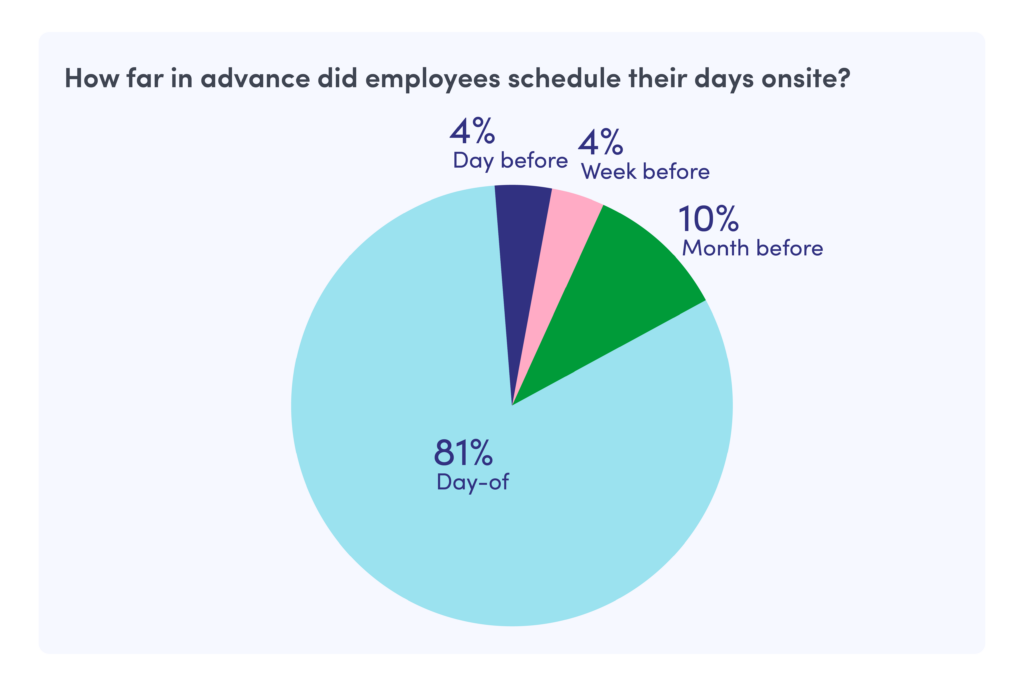
{{protip-3}}
Trend #4: Meeting rooms are being used more than ever
Meeting spaces were one of the most impacted parts of work life as a result of the pandemic. Work meetings went entirely digital for most office workers. However, the light at the end of the tunnel showed up in early 2021, when offices began to fill up again and a demand for meeting spaces grew. Employees not only needed meeting rooms to meet with their in-office counterparts, but also to conference call with their remote colleagues. They needed these spaces to be easily reservable, equipped with the right technology, and versatile. As companies enhanced their meeting room layouts and booking process, demand shot up. In fact, meeting room reservations tripled from 2021 to 2022.
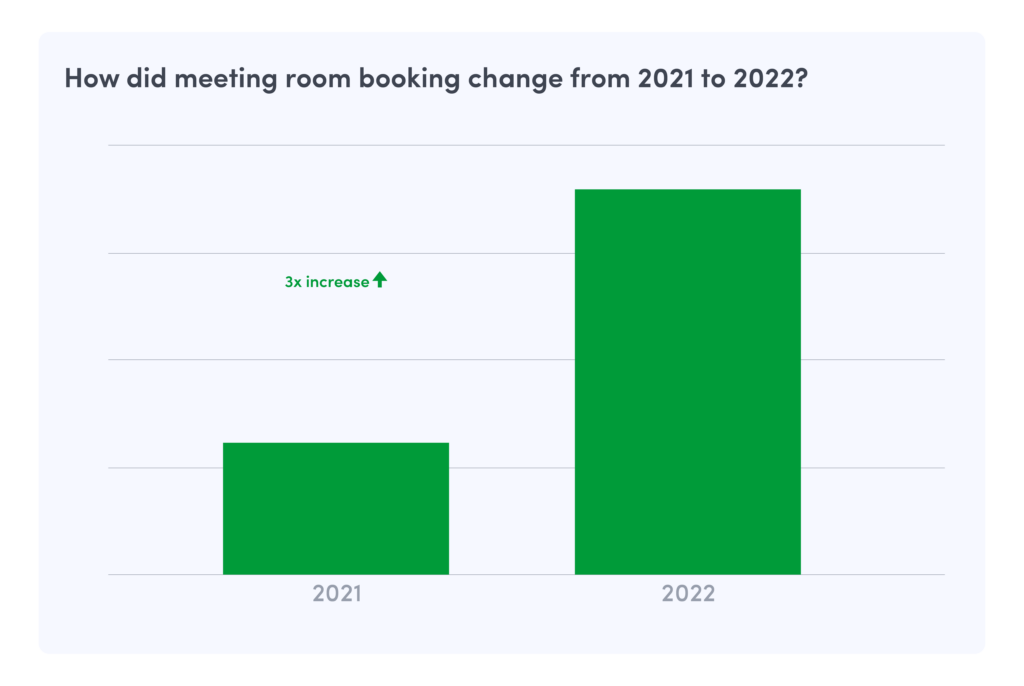
{{protip-4}}
Trend #5: Hybrid work is still topping the charts
Hybrid work has been around for a long time, but the last few years gave it a stage to reach its stardom. In fact, according to a survey of over 240 workplace leaders, hybrid work was the predominant work model in 2022. 82% of our survey respondents had some form of a hybrid policy. Among those hybrid policies, 47% of respondents followed a hybrid at-will model, which means that employees choose what days to come onsite. 22% were hybrid mix, which means the policy includes a mix of employee-chosen days and manager-selected days. When compared against our data from 2021, we found that the number of hybrid employees increased by 5%. Plus, the amount of employees who reported an 100% in-office policy decreased by 6%, and the amount of employees who reported an 100% remote policy decreased by 1%. This could be because hybrid work has continued to gain popularity for being the best of both worlds. Hybrid has offered companies a way to cut down on real estate costs, and offered employees a flexible schedule that fits their needs.
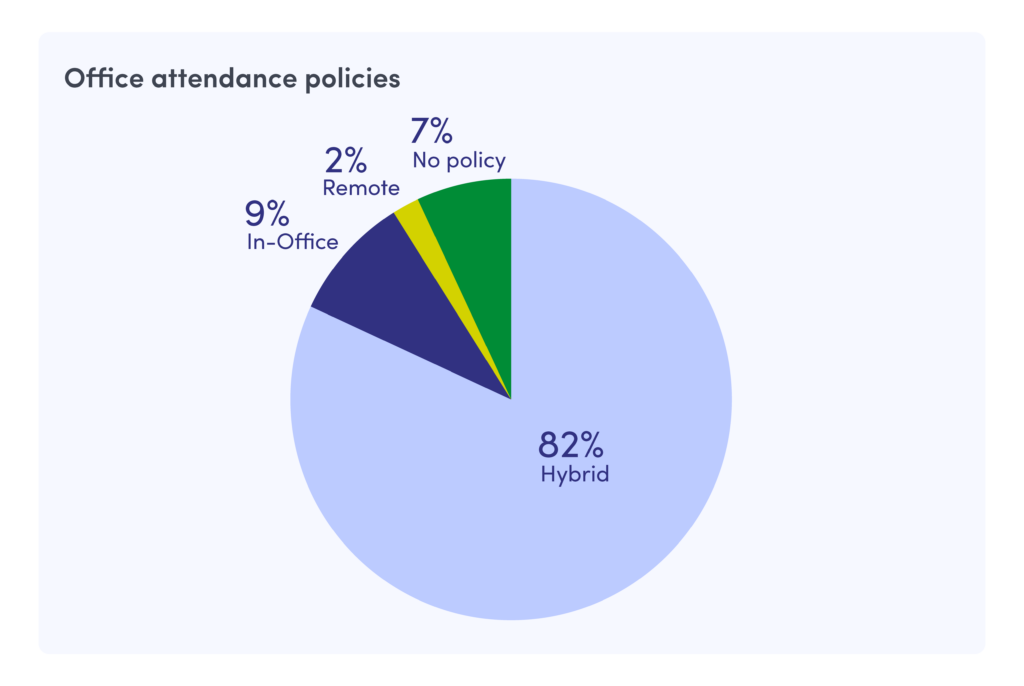
{{protip-5}}
Trend #6: Companies are investing real dollars behind collaboration
According to our At Work survey from October, 46% of leaders believe the purpose of the workplace is to build relationships and collaborate. Well, in 2022 they didn’t just talk-the-talk. They put real dollars behind that belief. 36% of this year’s survey respondents said their organizations changed their workplace by adding more collaboration spaces. That may have been casual lounge areas, meeting rooms, pods, or other spaces for groups to meet. This is an increase from last year’s At Work survey responses by 9%, indicating how much collaboration has grown in importance for companies everywhere. Other ways organizations changed their workplace to accommodate employees included more desks (23%), more meeting rooms (22%), and more social spaces (19%).On the flip side, some companies looked to make cost-saving decisions and reduce their real estate footprint with fewer desks (11%) and meeting rooms (4%). In 2022, 12% of respondents said they cut costs on real estate which is up 5% from the prior year. This might be because more companies moved to a hybrid model and realized they didn’t actually need as much real estate space as they did with an 100% in-office model.
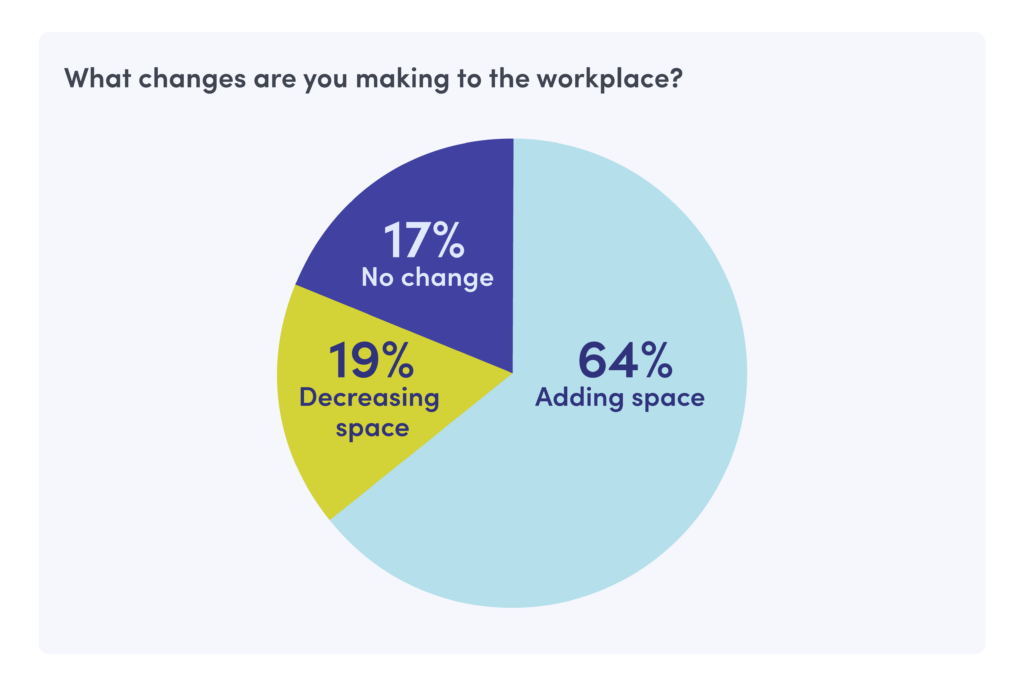
{{protip-6}}
—
Figuring out how to lead a business through uncertain economic times and the great remote vs onsite battle is tough. But leaders who are able to stay on top of trends and adjust where they can should expect their workplace to benefit from the investments.Understanding your employees behaviors when it comes to scheduling their days onsite, booking meetings, and hybrid work can give you a lot of direction on how to create a great employee experience. And understanding how the amenities and spaces in your workplace are being used can give you the guidance you need to build a great workplace experience.
Get ahead of the trend: Be prepared to welcome employees and visitors back onsite. Make sure you’ve got a seamless visitor management system set up. You’ll want to make sure anyone that enters your office is impressed by the time they leave.
Get ahead of the trend: Make sure your workplace teams are aware of the most popular days onsite, so they can make sure there’s enough food, desks, and meeting rooms available. Curious about the trends of your own company? Check your analytics dashboard to see employee sign-in patterns and figure out what the most popular days at your company are.
Get ahead of the trend: Employees are making decisions about whether or not to come onsite with pretty short notice. You’ll want to make sure your office is prepared to handle however many employees you expect to see. So you’ll want to think about tracking employee sign-in data or instituting a policy where employees have to schedule to come onsite at least a week before.
Get ahead of the trend: What does this mean for workplace leaders? It means that the quality of meeting rooms and the ease of booking them has to be a top priority in 2023. Consider adding a variety of meeting spaces into your workplace and equipping your employees with the best tools to reserve them.
Get ahead of the trend: Hybrid’s not going anywhere. Are you armed with the tools and workplace to support hybrid work for your employees? That means technology that supports employee scheduling or hot desking.
Get ahead of the trend: While choosing what to invest in is never an easy decision, the workplace should be at the top of your priority list. Investing in the workplace is a sure bet for long term impacts on people and business. Collaboration spaces and onsite programs are going to be important in building a great workplace experience in 2023.
Read more
Searching for a visitor management solution? Learn what to look out for and how to choose the best tech for your team.
Managing your space well doesn’t have to be difficult. But if you want to be successful, you need the right approach.
A well-run workplace can set your team up for success. Learn why workplace management matters and how to do it right.
Workplace security is critical to the future of your business. Learn why it matters, what threats to watch for, and how to strengthen your workplace security plan.
In this post, we’ll explore what workplace compliance is and how to build a compliance culture for your organization.
With more folks sending personal packages to the workplace, having a sound mailroom management system in place is key.









